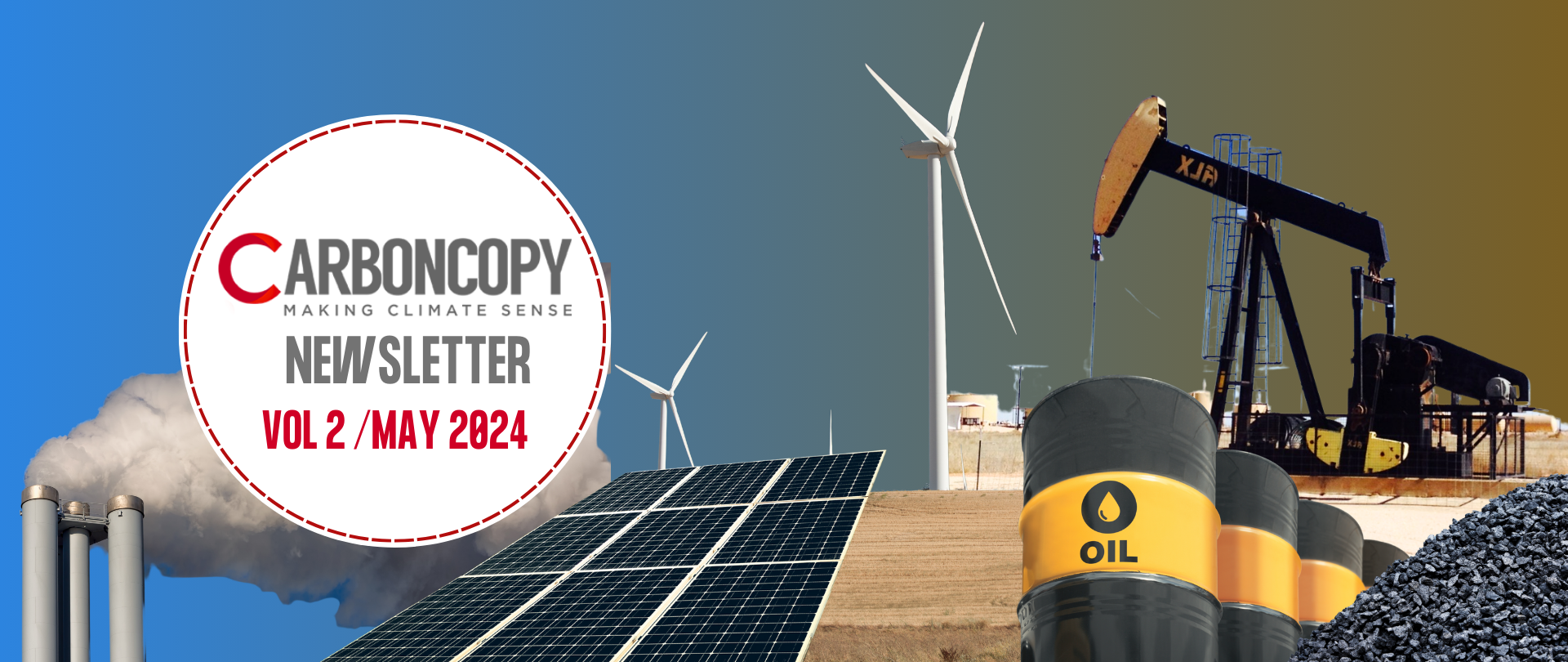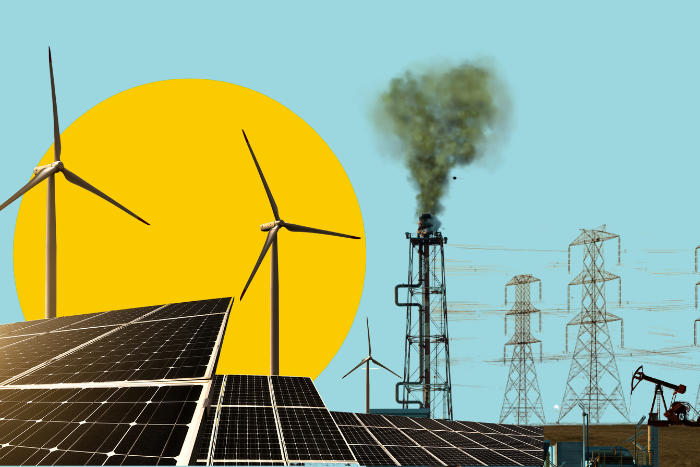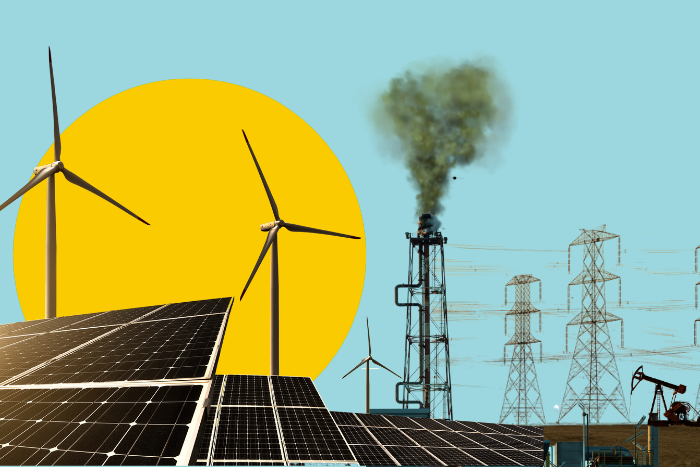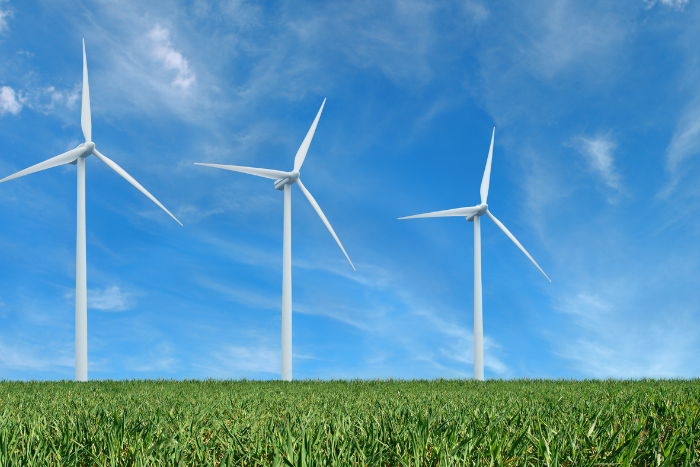


As the current administration ends its second term, CarbonCopy presents a report card on India’s energy sector that cannot completely let go of the old, while it tries to make room for the new. Read more
While coal continues to be a mainstay in India, renewables are growing, too.
India’s energy sector: Ten years of progress, but in fits and starts
As the current administration ends its second term, CarbonCopy presents a report card on India’s energy sector that cannot completely let go of the old, while it tries to make room for the new
How has India’s energy sector changed over the past ten years? The obvious way to answer that question vends through numbers. What percentage of India’s power sector runs on fossil fuels — as opposed to renewables? Is the country adding more renewable capacity or still erecting more oil, gas and coal-based plants?
Ask such questions and you will find relatively familiar answers. The country’s installed power capacity has climbed from 305 GW in 2015-16 to 441 GW now. While coal continues to be a mainstay, rising from 185 GW to 217 GW in this period, renewables are growing, too. Wind and solar now account for 128 GW of India’s installed capacity. India is adding more renewable than fossil fuel capacity. One could go on. While useful, these numbers are just the top of the proverbial iceberg.

A clutch of messier processes, some of them harking back to political economy, produce and shape the trends captured in these numbers. These processes — be it those that support the persistence of coal or India’s accretion of solar capacity – shape India’s energy transition.
They need to be understood. CarbonCopy presents outtakes from its nearly eight years of energy reportage.
1. India’s energy policy is muddled, it backs both renewables and fossil fuels
In 2020, CarbonCopy reported on how India seems to want everything at once. The government’s energy projections significantly outpace the country’s growth rate. It wants to double India’s oil demand by 2030; treble gas demand by 2030; boost coal production by 40% between 2018 and 2024; post a five-fold jump in the country’s renewable power capacity by 2030; and make all two-wheelers, all three-wheelers and a third of all four-wheelers electric by 2030. Subsequently, the government also projected large expansions in India’s hydrogen, nuclear, hydel and pumped storage capacity.
The reasons for this simultaneous push on renewables and fossil fuels is easy to understand. Fossil fuels are a major source of funds for the Indian state; Some of the country’s biggest businessmen have large investments in sectors such as oil, gas and coal; Fossil-fuel-rich countries lobby for these fuels as well — US shale gas startup Tellurian’s attempt to access the Indian market is one instance. In tandem, India’s attempts at central coordination of energy — to create integrated energy policy plans — have frayed over the past 10 years. Ministries running these sectors, keen to stave off their own obsolescence, are unilaterally sketching fresh expansion plans. Large consequences follow from here.
2. India is becoming the last big market for fossil fuels
Since 2017, a number of fossil fuel producers have invested in India. Most of these investments are not in exploration but in downstream activities like oil refining and distribution networks. Rosneft bought Essar’s refinery. Aramco and ADNOC announced plans to set up a refinery in Ratnagiri. Total invested in Adani Gas. Novatek tied up with Hiranandani.
The logic is evident. Fossil-fuel-rich countries wanted to sell as much of their inventory as they could. India is playing along — even using this new clout for fresh diplomatic and geopolitical gains. Nowhere is this more evident than in the gas sector. Even though imported gas is much costlier than any of the fuels it wants to replace, India wants to boost the share of gas in its energy mix to 15%.
With that, countries like Qatar, Russia and the USA are trying to sign long-term gas supply deals with India.
These purchases, however, might prove to be white elephants for the country.
3. Price, not policy, is shaping India’s energy transition
In the absence of policy, price is determining the contours of India’s energy transition. As battery storage and solar panel prices continue to fall — and 24×7 bids for wholly RE power, including batteries, solar, wind and hydel, come in — alternative forms of energy are struggling to stay competitive. Be it imported gas, nuclear, hydel or even thermal power.
With that, the country might be saddled with under-utilised capacity or dud investments (be it small and modular reactors, dams or imported gas deals).
In response, fossil fuel majors are rebundling. Players like NTPC and Adani are backwards and forwards integrating — stretching out to cover the entire power supply chain from coal mining to power distribution — to squeeze out additional efficiencies.
A power plant with its own Discom doesn’t have to wonder when payments will come. A power plant with a captive coal block, similarly, doesn’t have to worry about coal stockout or poor quality of coal.
This search for competitiveness comes with its own consequences.
4. The rise of megaliths in India’s power sector
A standalone thermal power plant is less competitive than a power plant with its own distribution company. And, as CarbonCopy wrote in 2021, a power plant with its own Discom will be less competitive than a rival with its own coal block, transmission lines, power plant and Discom.
And so, India’s power sector is seeing consolidation. Adani, which started with thermal power, has not only entered everything from coal mining to Discoms, it has also expanded laterally — moving into renewables generation; be it solar, wind or pumped storage. NTPC is rebundling as well. The logic is simple. Bundling solar power with more expensive thermal power, to take one instance, gives an extra lease of life to uncompetitive TPPs.
Conglomerates like Adani and Ambani have also forayed into RE manufacturing. In all, a baton is being passed in India’s energy sector. The early movers in the sector were standalone players, each occupying a rung or two in India’s unbundled energy landscape — TPPs, discoms, RE manufacturers, assemblers, developers.
That is changing now. Not only are the conglomerates coming in, even the early movers in energy are backwards integrating into manufacturing — and diversifying into multiple forms of energy.
5. Solar is about to take off
Late last year, India’s power sector crossed a rubicon. A tender by Indian railways, seeking Round The Clock (RTC) renewable power netted a price lower than that of coal. Even as India continued to back fossil fuels – and failed to create a robust market architecture for renewables – market forces have been at work. Prices of solar modules and battery storage have been steadily dropping, bringing the country finally to this point where renewables no longer need to be backed up by thermal power.

If the country gets its act on land acquisition, transmission and financing together, it will see a massive jump in renewable capacity from here on. Over the next three years alone, it could add anywhere between 80-100 GW in solar alone, as CarbonCopy is told by industry bodies and senior government officials.
6. A large battle on the contours of power distribution is brewing
Between solar’s expansion and large power producers’ diversification, India’s power sector stands at the cusp of radical transformation. According to an official at the National Solar Energy Foundation of India, not only are large power consumers trying to create their own renewable arrays, firms like Adani and Ambani are also said to be eyeing the large merchant power market, offering 24×7 renewable power to firms, especially those exporting to regions like the EU.
There is also speculation that Ambani might offer micro-grids to retail consumers. Reliance Jio had given phones away for free but charged for airtime, this reporter was told in 2021. In energy, too, it is speculated that Reliance will set up free renewable energy infrastructure in residential clusters and industrial areas — think small local grids comprising solar/wind installations and electrolysers that deliver 24×7 power — and charge only for the power. Such a model would disintermediate Discoms — and take the country towards a new future of microgrids.
Other firms, like Adani, are following the existing template of centralised power generation, power generated in large solar parks and then ported across large distances through transmission lines and subsequently distributed through Discoms. This is very much an area to watch. How will the power sector change over the next ten years?
7. With decarbonisation, India’s economic geography is changing as well
As recently as five years ago, India’s energy landscape was well ordered. Central and eastern India produced coal. Thermal Power Plants came up around them — or near large consumption centres. Large consumers of steel, too, usually, came up near coal mines.
This economic geography around energy is changing now. As Niti Aayog data shows, most renewable energy parks are coming up along western India. In tandem, most investment into renewable technology — like e-mobility — is also flowing into states in the south and the west. Principally, Tamil Nadu, Telangana, Karnataka, Maharashtra and Gujarat. Even as these states compete to land projects, states like Jharkhand, Odisha and Chhattisgarh have to contend with questions about a just transition.
They might not be able to replace their coal mines and power plants with renewable alternatives. Their steel plants might take a pounding as well. Not only are smaller steel plants losing competitiveness, larger steel plants are under strain due to carbon border taxes, etc. In all, the world is seeing a reallocation of steel manufacturing capacities.
Region after region in India slipped into ruin as their economic clout dwindled. What does the coal-belt do?
8. Mission drift for energy PSUs?
In all this, India’s state-owned energy firms are scrambling for answers.
NTPC is expanding beyond thermal power plants into hydel and nuclear power. Coal India is expanding beyond coal mining into thermal power plants, solar parks and critical minerals’ exploration. NHPC is looking beyond dams at thermal, solar and wind. IOC is looking at hydrogen, solar and wind. ONGC is thinking of getting into oil-to-chemicals plants. GAIL wants to get into photovoltaic manufacturing.
Hardwired into these diversifications are larger questions. In the case of nuclear, NTPC has partnered with NPCIL for large plants, but wants to go it alone for SMRs. Similarly, Coal India is foraying into thermal at a time when the sector’s economics are eroding. Questions about core competency — and if this is the best just transition that can be planned for these organisations — come to mind.
Endgame
In addition to these, a clutch of other processes are shaping India’s energy transition.
As with India’s abortive hydel and thermal power plant booms, a clutch of politically connected firms are moving into the renewable sector as well. Their capacity to deliver has to be tracked. With its capacity to determine the viability of RE investments, climate finance is a large bone of contestation. As are India’s attempts to source critical minerals — whether through overseas deals, domestic mining or intensive recycling. There will be others.
This is our ongoing moment in energy. Global oil and gas majors are vying to sell more hydrocarbons to India. The country lacks a clear energy transition roadmap. The domestic energy sector is consolidating into an oligopoly with firms straddling renewables and fossil fuels. The country’s economic geography (around energy) is changing. Renewables, however, are on the cusp of massive expansion. Just transition is elusive. SPSUs have embarked on uncertain transitions.
All of which brings us to a larger question. By the end of the current government’s second term, India is getting hit harder by climate change. It needs to decarbonise urgently. The processes driving decarbonisation, however, are multi-variate, with some even working at cross-purposes.
And yet, decarbonisation is one vector along which India’s fight against climate change has seen the most progress. On other fronts, like adaptation (climate-ready cities) and mitigation (curbing pollution), the country is doing even more poorly.
The country will get a new government soon. One of the tasks before it? A winnowing of these processes.
Children, elderly people and those with chronic diseases are most susceptible to the heat impact.
Delhi temperatures hit a record high, several casualties reported in Rajasthan
Delhi temperatures crossed a record high of 52.9 °C in Delhi’s Mungeshpur on Wednesday, more than 12 degrees higher than expected, but India’s weather office, the IMD said, that it could be an error or because of local factors. However it was the second day of record-breaking heat according to IMD. On Tuesday it recorded 49.9 °C in Mungeshpur and Narela, breaking the 2002 record of 49.2 °C.
Children, elderly people and those with chronic diseases are most susceptible to the heat impact. More than 50 students were rushed to hospital in the town of Sheikhpura in Bihar after fainting due to high temperatures, local media reported. In Jammu and Kashmir, authorities are tackling a number of forest fires that are being fuelled by the heat.
The soaring temperatures have also been linked to scorching winds from Rajasthan state, where temperatures reached just above 50°C.
Meanwhile, a new study by Delhi-based think tank Centre for Science and Environment (CSE) revealed a worrying phenomenon. Cities are not cooling down at night as much as they did during 2001-2010. A report in HT stated 23 states have heat action plans, but they are not being implemented. Only four heat action plans identified the elderly, children, and pregnant women as being vulnerable to heat-related illness.
Monsoon hits Kerala, arrives earlier than usual
India’s monsoon season arrived earlier than usual this year. Kerala reported heavy rainfall on Thursday and the regional meteorological centre in Thiruvananthapuram issued an ‘orange rain alert’. Last year, the monsoon season was delayed by a week and arrived on on June 8. Monsoon onset over Kerala is an important indicator characterising the transition from a hot and dry season to a rainy season, HT reported, adding that India’s agriculture ministry data says 51% of farmed areas, accounting for 40% of production, are rain-fed, making the monsoon critical, HT reported.
Cyclone Remal hits Bangladesh and India, leaving destruction and death
Cyclone Remal, which made landfall in low-lying Bangladesh and neighbouring India on May 26 evening with fierce gales and crashing waves, left at least 38 people dead, destroyed thousands of homes, smashed seawalls and flooded cities across the two countries, AFP reported.
Rescue workers have so far retrieved 29 bodies from several landslide-hit locations in and around Mizoram’s capital Aizawl. The toll includes 12 workers, who died on May 28 when a stone quarry collapsed in Mizoram, because of torrential rains as the storm progressed inland.
Bangladesh’s weather experts said the deadly cyclone was one of the quickest-forming and longest-lasting they’d experienced, blaming climate change for the shift. In Bangladesh, the storm killed 13 people and damaged or destroyed more than 35,000 homes across the coastal areas, affecting about 3.5 million people.
Two persons died in two different incidents in Manipur‘s Senapati district due to landslide and flooding after Remal triggered heavy rainfall, according to officials.
Climate change has intensified “flash droughts” by 60%, 80% and 90% in Afghanistan, Pakistan and India, respectively: Study
Man-made climate change has intensified flash droughts in the spring-summer season, with attributable risk of 60%, 80%, and 90% for Afghanistan, Pakistan, and India, respectively, according to new research. The scientists warned that flash droughts will expand and worsen in the future, requiring adaptation measures for the water, agriculture, and energy sectors.
The researchers said flash droughts are more common and intense in the crop season, especially in central India, western Pakistan, and eastern Afghanistan. They are caused by persistent atmospheric patterns that block moisture transport to South Asia. Flash droughts are abrupt and rapid intensification of droughts that affect agriculture, water, and ecosystems and are commonplace in South Asia.
Flash droughts in south Asia are caused by persistent atmospheric patterns that block moisture transport, the researchers said. They are “more common and intense in the crop season, especially in central India, western Pakistan and eastern Afghanistan”.
Farmland trees that provide shade decline at alarming rate amid heat surge: Study
A new study found that India’s farmlands have lost large trees with big crowns at an alarming rate. Of the 0.6 billion farmland trees mapped In India in 2010-11, around 11% had disappeared by 2018, the Department of Geosciences and Natural Resource Management at the University of Copenhagen study said. These are trees with about 96 sqm crown cover.
Most of the trees have been lost in Telangana, Haryana, Kerala, Maharastra, Andhra Pradesh and Uttar Pradesh, where extreme heat is more pronounced.
The study noted that trees such as jackfruit, jamun, mahua, neem and others offer shade and are a source of livelihood for small farmers. Moreover, during 2018-2022, more than five million large farmland trees (about 67 sqm crown cover) have vanished, partly due to altered cultivation practices, where trees on farms are perceived as detrimental to crop yields.
Authors said this is a setback to agroforestry as a pivotal natural climate solution, important for supporting agricultural livelihoods and improving biodiversity. The authors of the study said 56% of India is covered by farmland, and only 20% is covered by forest. While the separation of forests and tree plantations is not always clear, it is certain that these classifications exclude a large part of India’s trees scattered within farmlands, in urban areas or grown as hedgerows, the authors said.
Developed countries provided and mobilised $115.9 billion in climate finance for developing countries in 2022, up from $89.6 billion in 2021.
Late by 2 years, rich countries meet $100bn climate finance goal for the first time
Two years late, rich countries for the first time in 2022 delivered on a longstanding pledge to channel $100 billion a year in climate finance to developing nations, according to the new data from the Organisation for Economic Co-operation and Development (OECD). Developed countries provided and mobilised $115.9 billion in climate finance for developing countries in 2022, up from $89.6 billion in 2021, reported Climate Home News.
The news portal added that the year-to-year increase of around 30% was the largest to date and was driven by significant funding increases from multilateral development banks – which contributed the most at $50.6 billion – individual governments and private finance mobilised by using public money to reduce investment risk.
Experts have raised issues about the data. The process is riddled with ambiguity and inadequacies,” Harjeet Singh, a climate activist, said in a statement to DTE, adding that
much of the funding is repackaged as loans rather than grants and is often intertwined with existing aid, blurring the lines of true financial assistance. “We need more transparency in the accounting and reporting framework, especially since there is no agreed-upon definition of climate finance and what needs to be counted as part of it,” Sehr Raheja,of Centre for Science and Environment, told Down To Earth.
Notice to Assam govt over police battalion camp in Geleky reserve
The Centre sought a report from Assam government on the alleged illegal diversion in 2022 of 28 hectares of the Geleky reserve forest on the Assam-Nagaland border for a police battalion camp. HT reported the environment ministry slapped the notice citing the newspaper’s report.
The letter is addressed to additional chief secretary (forests), Assam, a colleague of MK Yadava, the former Principal Chief Conservator of Forests who approved the diversion. Yadava, has 60 days to respond to the Union environment ministry’s notice. The use of forest land for non-forestry activities was allowed without prior approval of the Central Government, the ministry said in a letter dated March 18 asking the Assam government to stop all construction activities in the aforementioned area/ land in question. On April 10, HT reported that the same official allowed construction by a commando battalion unit in a protected forest in Hailakandi in Assam, ostensibly to stop encroachments by Mizo people from neighbouring Mizoram, creating a furore among local conservationists, compelling the Union environment ministry to take notice and direct the state government, in March this year, to immediately halt construction.
Climate change is compelling Bangkok to relocate?
Thailand may relocate its capital Bangkok because of rising sea levels, a senior official in the country’s climate change office told AFP on Wednesday. Projections consistently show that low-lying Bangkok risks being inundated by the ocean before the end of the century. The busy Capital already battles flooding during the rainy season, the newswire reported.
Pavich Kesavawong, from the department of climate change and environment, warned that the city might not be able to adapt with the world on its current warming pathway. Bangkok’s city government is exploring measures that include building dikes, along the lines of those used in the Netherlands, he said. “Bangkok (would) still be the government capital, but move the business.” While a move is still a long way from being adopted as policy, it would not be unprecedented in the region. Indonesia will inaugurate this year its new capital Nusantara, which will replace sinking and polluted Jakarta as the country’s political centre, AFP reported.
Paris Climate Accord is not enough to protect oceans, says international court
Greenhouse gas emissions absorbed by the ocean were considered marine pollution, and countries are obliged to protect marine environments by going further than the requirements of the Paris climate agreement, said an international marine court in its verdict.
The International Tribunal for the Law of the Sea (ITLOS) in Hamburg, Germany, gave its advisory opinion on whether countries have a responsibility to reduce emissions and fight climate change – a judgement that could give legal leverage to future climate cases, reported Reuters.
Germany waters down its climate protection law, drops sectoral targets
Germany approved a “controversial” reform of the climate protection law, that eliminates sectoral targets, reducing pressure on sectors such as transportation and buildings, which previously “failed to meet their legal requirements”, Carbon Brief published the translation of the Zeit report. According to the new law, adjustments for the climate protection plan will only be necessary if Germany’s overall goal of achieving climate neutrality by 2045 is at risk.
Now, Germany will reduce its greenhouse gas emissions by 65% by 2030 relative to 1990, by 88% by 2040, and achieve carbon neutrality by 2045. The law’s previous version set the annual emission caps for individual sectors of the economy (energy, industry, transport, construction, agriculture and waste management) to 2030, and the relevant ministries were responsible for enforcing these caps. The amendment removes the provisions making individual ministries responsible for progress in decarbonising their respective sectors, in favour of the collective responsibility of the government as a whole. In addition, from now on, the council of experts will change its approach to evaluating progress in cutting emissions: instead of assessing the previous year’s data retrospectively, it will prepare an annual, multi-year cumulative forecast for reducing emissions across all the sectors of the economy (first by 2030, then by 2040 and 2045), reported OSW.
Meanwhile a German court ruled that current federal measures to reduce CO2 emissions in various sectors by 2030 are deemed “insufficient” and will fall short of the government’s legally binding targets for the coming years, notes DW. Therefore, in its current form, the Climate Protection Act adopted last October “does not fully meet the legal requirements”,
Economic damage from climate change six times worse than thought: Report
Climate change is causing financial loss six times more than previously thought, says a new report, adding that global heating is set to shrink wealth at a rate consistent with the level of financial losses of a continuing permanent war. A 1°C increase in global temperature leads to a 12% decline in world gross domestic product (GDP), the researchers found. The world has already warmed by more than 1°C (1.8F) since pre-industrial times and many climate scientists predict a 3°C (5.4°F) rise will occur by the end of this century due to the ongoing burning of fossil fuels, will come with an enormous economic cost.
A 3°C temperature increase will cause “precipitous declines in output, capital and consumption that exceed 50% by 2100” the paper stated. This economic loss is so severe that it is “comparable to the economic damage caused by fighting a war domestically and permanently”, it added.
UK: Transatlantic air fares to jump under net-zero fuel rules
The cost of sustainable aviation fuel (SAF: blend of waste oils, animal fats and ethanol from corn) will be passed on UK travelers who may have to pay £40 more for a return trip to New York as a result of incoming net zero regulations, according to figures from Virgin Atlantic.
The extra burden on travellers is expected if the cost of sustainable aviation fuel (SAF) is passed on directly. Calculations by Virgin Atlantic, a pioneer in using the greener jet fuel, show that ticket prices would have to rise 6%. For a return flight to New York that would amount to a £40 increase at current prices, based on two one-way fares costing about £350 each, reported Telefgraph.
If SUVs were a country, the IEA said, they would be the world’s fifth-largest emitter of CO2.
50% of new cars sold in 2023 globally were polluting SUVs, data shows
Sales of polluting SUVs hit a new record in 2023 at 50% of all new cars sold globally, data revealed. Increasing number of new heavy vehicles is pushing up the carbon emissions that drive global heating, scientists warned. The International Energy Agency (IEA) found that the rising emissions from SUVs in 2023 made up 20% of the global increase in CO2, making the vehicles a major cause of the intensifying climate crisis. If SUVs were a country, the IEA said, they would be the world’s fifth-largest emitter of CO2, ahead of the national emissions of both Japan and Germany, the Guardian reported.
Climate-fuelled extreme weather is increasing, with urgent cuts in emissions needed. But emissions from the global transport sector have risen fast in recent years. SUV sales rose 15% in 2023, compared with a 3% rise for conventional cars, the newspaper reported.
Discharge of toxic water from factories in Jodhpur: NGT asks authorities to file response
The Rajasthan State Pollution Control Board, Central Pollution Control Board and the Collector/District Magistrate, Balotra, Rajasthan, have been asked to respond to National Green Tribunal’s (NGT) notice for violating the water act by releasing toxic chemicals in water bodies.
DTE reported that according to news published in Balotra Patrika on March 16, 2024, the chemical-mixed water from the cloth manufacturing factories in the the Doli-Aaraba area has reached Kalyanpur, Balotra district. This has been causing serious inconvenience to villagers. No action has been taken by the authorities despite many days having passed. The Water Act, 1974, and the provisions of Environment Protection Act, 1986, had been violated, the news report stated. India’s green court (NGT) directed authorities to file a response.
Units manufacturing formaldehyde without green clearance in Yamunanagar, Haryana
Cancerous chemicals seeping in ground water from illegal formaldehyde manufacturing units continue to haunt Haryana. The NGT once agan directed the Haryana State Pollution Control Board on May 15, 2024, to file its reply on units manufacturing formaldehyde operating in Haryana’s Yamunanagar without obtaining any environmental clearance (EC). The respondents have to file their affidavits at least one week before the next date of hearing (August 30, 2024), the order said.
The factories use copious amounts of water and pollute the groundwater and air significantly, an earlier NGT order had said. The illegal units pose serious health hazards. There is no mechanism to check leaching of methanol from underground tanks.
German company BASF to pay $316 million to settle ‘forever chemicals’ US lawsuit
German chemical company BASF will pay $316.5 million in settlement to some US public water systems that claimed toxic “forever chemicals” in firefighting foam made by the company contaminated their water supplies, reported Reuters. PFAS are a class of chemicals used in thousands of consumer and commercial products, including firefighting foams, non-stick pans and stain-resistant fabrics. They have been tied to cancers and other diseases, and are often called forever chemicals because they do not easily break down in nature or the human body.
BASF said the settlement does not constitute an admission of liability or wrongdoing, and that it will seek to recover for the settlement through its numerous insurance policies.
Meghalaya unveils e-waste bin initiative to combat electronic pollution
In a move to tackle the mounting electronic waste (e-waste) menace in the state, the Meghalaya State Pollution Control Board (MSPCB) joined hands with Hulladek Recycling Private Limited to introduce dedicated e-waste bins across the state.
During the launch, MSPCB Member and Secretary, GH Chyrmang, presented a comprehensive report on the state’s e-waste scenario, revealing that commercial establishments, educational institutions, and offices are the major contributors. Reportedly, Shillong generates the highest e-waste, followed by the West Garo Hills.
Pollution poisons Periyar: Thousands of fish perish
Thousands of dead fish were found floating on the surface of the Periyar River and Kochi backwaters, along the stretch from Pathalam to Thanthoni Thuruthu and Vypeen islands. The water turned black and emitted a strong stench of decaying fish, TOI reported. Local residents suspect industrial units discharged toxic effluents, poisoning the water.
Shabeer OV, a member of the Periyar watch team of Periyar Maleenikkara Virudha Samithi (PMVS) said taking advantage of flooding when authorities open shutters to release flood waters the industrial units have released their stored effluents and waste during the night when they realized that the shutters would be opened after the rainfall warning.
Wind power capacity provides grid balancing and continuous power supply in contrast with solar power, which is limited to daylight hours.
India will boost wind energy capacity to 25 GW by 2028, with ₹2 lakh crore investment
India is going to spend between ₹1.8 lakh crore and ₹2 lakh crore, to significantly increase its wind energy capacity, with a projected addition of nearly 25 gigawatts (GW) between fiscal years 2025 and 2028, compared to about 9 GW added between 2021 and 2024, Crisil Ratings said.
Wind power capacity provides grid balancing and continuous power supply in contrast with solar power, which is limited to daylight hours. “Hybrid and storage-linked projects would push higher wind additions. Nearly 30-50% of capacity of these projects will comprise wind power as these require developers to provide renewable power throughout the day, especially demand peaks during evening and night hours,” Ankit Hakhu, director, Crisil Ratings, said. India’s focus on wind energy had previously slowed, with annual capacity additions dropping to 1.7 GW from 2018 to 2023, down from approximately 3.0 GW annually from 2014 to 2018. The decline was attributed to a lack of connected sites with high wind potential and diminished returns for developers following aggressive bidding.
Glitches in national portal slow down rooftop solar installations
National Portal, which serves as a platform to commission residential solar systems, is facing bugs and glitches, which is impacting business of rooftop solar installers, Mercom reported. The portal is used for registration, uploading feasibility documents and project completion reports and applying for subsidy. The portal’s instability has caused a backlog of thousands of pending requests, leaving installers and customers frustrated, the outlet said.
Last year’s peak season, rooftop solar installer Surendra Chaudhary’s firm Solar Planet raked in ₹4 million (~$48,000) to ₹5 million (~$60,000) a month. Business is now bringing him a mere ₹300,000 (~$3,600) to ₹400,000 (~$4,800) a month. “Customers have lost faith in us because it is impossible to do anything on the portal,” he said, adding that there are new bugs every step of the way, the outlet reported.
Solar wafer prices decline, sparking concerns over producer survival prospects
Prices of Chinese solar wafers have drastically fallen this week once again, underscoring the prevalent oversupply and the lackluster demand in the market, reported PV Magazine. Mono PERC M10 and N-type M10 wafer prices decreased by 2.58% and 8.81% week-to-week, reaching $0.189 per pc and $0.176/pc, respectively.
Similarly, Mono PERC G12 and n-type G12 wafer prices dropped by 0.76% and 2.18% week-to-week at $0.261/pc and $0.269/pc, respectively. According to OPIS’ market survey, the average transaction prices of Mono PERC M10 and N-type M10 wafers in the Chinese domestic market have descended to around CNY1.52 ($0.21)/pc and CNY1.41/pc, respectively. OPIS, a Dow Jones company, provides a quick look at the main price trends in the global PV industry.
An industry insider even cited a transaction price of CNY1.35 for n-type M10 wafers, suggesting the potential direction of n-type wafer prices in the immediate future.
Solar projects in SEZs catering to green hydrogen plants exempt from ALMM
Solar PV modules for renewable energy projects located inside a Special Economic Zone (SEZ) or an Export Oriented Unit (EOU) and supplying power exclusively to green hydrogen (or its derivatives) projects have been exempted from the Approved List of Models & Manufacturers (ALMM) by the Centre, reported Mercom.
The ministry defines green hydrogen as hydrogen produced using renewable energy, including but not limited to production through electrolysis or biomass conversion.
In another memorandum, the ministry also gave a similar exemption to renewable energy projects from the purview of the Revised List of Models & Manufacturers (RLMM) for wind turbine models under the guidelines for development of onshore wind projects.
By facilitating bi-directional energy transactions, the V2G project will investigate how EVs can help the grid during peak and off-peak hours.
Tata Power-DDL to demonstrate vehicle-to-grid technology in North Delhi
In an effort to improve grid stability and EV utility, Tata Power Delhi Distribution Limited (Tata Power-DDL) and the India Smart Grid Forum (ISGF) teamed up to implement a Vehicle-to-Grid (V2G) technology demonstration project in North Delhi. By facilitating bi-directional energy transactions, the V2G project will investigate how EVs can help the grid during peak and off-peak hours. This entails offering crucial grid services, including voltage and frequency support, evaluating the suitability of EVs as standby power sources in the event of an outage, and researching the effects of bi-directional charging.
Scientists develop new hydrophobic, anti-reflective coating for solar glass
Scientists in Slovakia created a unique hydrophobic, antireflective coating for solar glass that consists of an inorganic-organic upper layer made of silica modified with triethoxy(octyl)silane and a bottom layer of silica-titania thin film. When compared to uncoated glass, this novel coating enhances glass transmittance by 7%. The study effectively built a double-layer hydrophobic AR using the sol-gel process, which has become a promising method of depositing films. Numerous benefits come with the technique, including its low cost, a large selection of precursors, low synthesis temperature, and superb control over the structural and morphological properties of the films. The outcomes show that the double-layer coating is a viable way to lower reflection and enhance glass substrates’ optical qualities, the researchers said. This coating has potential applications across a range of industries, but it is especially useful in the solar cell industry where it can boost the stability and efficiency of solar cells.
Australia launches policy to promote the development of the battery industry
The Australian government launched its first “National Battery Strategy” in an effort to encourage the growth of a competitive and diverse battery industry in the country. 5.23 billion Australian dollars will be invested by the government to help regional battery producers strengthen their position in the value chain, develop future battery capabilities, and strengthen inter-country cooperation. Furthermore, a 17-billion Australian dollar fund will be established to aid in the development and commercialisation of initiatives in important fields including renewable energy technologies. Additionally, tax breaks will be offered to encourage the mining of important minerals in Australia. Starting with the fiscal year 2027–2028, funds will be given to the Australian Renewable Energy Agency (ARENA) for the ensuing 10 years. Investments of 0.91 billion Australian dollars are to go towards building a clean energy workforce.
Export of Chinese EVs rising in Brazil before stricter import tax is implemented
Brazil became China’s top export destination for the second consecutive month in April as the country’s exports of plug-in hybrid and pure electric vehicles increased 13 times year-on-year to 40,163 units, according to figures from the China Passenger Car Association (CPCA). The sharp rise in exports to Brazil, the tenth-largest export market in January, coincided with a decrease in shipments to European markets by Chinese manufacturers of electric vehicles in anticipation of an EU anti-subsidy investigation. The surge in exports to Brazil coincides with the impending July tariff hike on imports of electric and hybrid vehicles. A 10% tax on the importation of fully electric cars (EVs) went into effect in January. This tax will rise to 18% in July and ultimately reach 35% in July 2026. A number of Chinese manufacturers have already begun to raise their investments in order to support local production in Brazil.
New US LNG projects run the risk of being delayed following Biden's decision in January to review the present permission process and freeze new LNG project permits.
US LNG projects run risk of being delayed
Amidst the Biden Administration’s effort for lower emissions and the ongoing evaluations about the environmental impact of the planned export facilities, new US LNG projects run the risk of being delayed. Following Biden’s decision in January to review the present permission process and freeze new LNG project permits, the US administration is seeking to impose more stringent regulations on the amount of pollution that export facilities are permitted to release into the neighborhood. Projects are getting delayed due to the additional criteria. Due to heat waves in certain regions of Asia and predictions of above-average temperatures in China and Southeast Asia in the upcoming weeks, there has been an increase in the purchase of spot LNG, driving up spot prices in Asia this week to their highest point since early January. And as Houthi attacks on ships going through the Red Sea has resulted in the redirection of maritime trade in the area, several analysts have predicted that the rerouting of marine transit will result in higher prices and slower deliveries of products. LNG was no different, with commentators suggesting that the longer travel times and possibility of market fragmentation would lead to a reduction in the availability of LNG carriers.
Climate pledges by top oil companies failing on every front: Report
A recent report by the research and advocacy group Oil Change multinational analysed the climate policies of the eight biggest multinational oil and gas producers in the US and Europe. The analysis found that even though these companies—BP, Chevron, ConocoPhillips, Eni, Equinor, ExxonMobil, Shell, and TotalEnergies—had made significant commitments to reduce their emissions, none of them were consistent with keeping global warming to 1.5°C over pre-industrial levels. Each aspect of each company’s plan was assessed using 10 criteria, ranging from “fully aligned” to “grossly insufficient”, the Guardian reported. The analysis showed that all eight organisations scored “insufficient” or “grossly insufficient” on almost all of the aspects. In each of the ten categories, the US companies Chevron, ConocoPhillips, and ExxonMobil received a “grossly insufficient” ranking. The report also said the companies’ current oil and gas extraction plans could lead to more than 2.4°C of global temperature rise.
Incoming Dutch govt plans for more offshore extraction, nuclear energy
The Netherlands’ incoming government stated that it intends to lessen the country’s reliance on “unreliable countries” by increasing nuclear energy production and offshore natural gas extraction, according to Reuters. The right-wing administration stated in its coalition agreement draft that it would not impose further national limits on top of the already agreed-upon international climate goals. This implied the cancellation of the proposed extra national carbon dioxide tax. The four political parties in the potential administration have conservative and populist ideologies, which align with the aims to strengthen energy security in the Netherlands. They also show the challenges the nation experienced when the war in Ukraine broke out in 2022 and it lost access to Russian gas. The nation’s intentions to increase offshore wind seem to be unchanging, but there will be less emphasis placed on building new wind turbines on land. Furthermore, the agreement restated intentions to enhance nuclear energy generation in the Netherlands.
US to end federal leases in the most coal-rich region of the country?
The Biden administration recommended ending new coal leasing from federal reserves in the Powder River Basin region of Wyoming and Montana — which is the most productive coal mining region in the United States. This proposal was prepared in response to a 2022 court decision that found that two federal land management plans for the Powder River Basin, created during the administration of former President Donald Trump, had not sufficiently considered the effects of burning coal on public health and climate change. In response, the Biden administration is releasing plans that would maintain the terms of current leases while prohibiting new coal leasing in the area. Before the plans are finalised, there will be a 30-day opportunity for public opposition. The idea, according to environmentalists, represents a historic turn in the country’s coal programme, which for the previous 50 years has enabled businesses to obtain cheap coal from vast strip mines, mostly in Western regions, in quantities amounting to billions of tonnes.
Trump’s deal with Big Oil to save the industry $110 billion?
According to the Guardian, Donald Trump is reportedly offering a deal to Big Oil CEOs in exchange for $1 billion in campaign contributions. If he wins reelection to the White House, the agreement might save the sector $110 billion in tax benefits. More than 20 CEOs, including those from Chevron, Exxon, and Occidental Petroleum, attended a fundraising event hosted by Trump. In exchange, Trump promised to lift drilling restrictions, abandon the moratorium on petrol exports, and undo recently implemented laws meant to reduce vehicle emissions if elected. The tax code seems to be the primary driving force behind oil and gas firms’ support for Trump; if Joe Biden is re-elected in November, the industry stands to gain approximately $110 billion in tax cuts, the report added.













